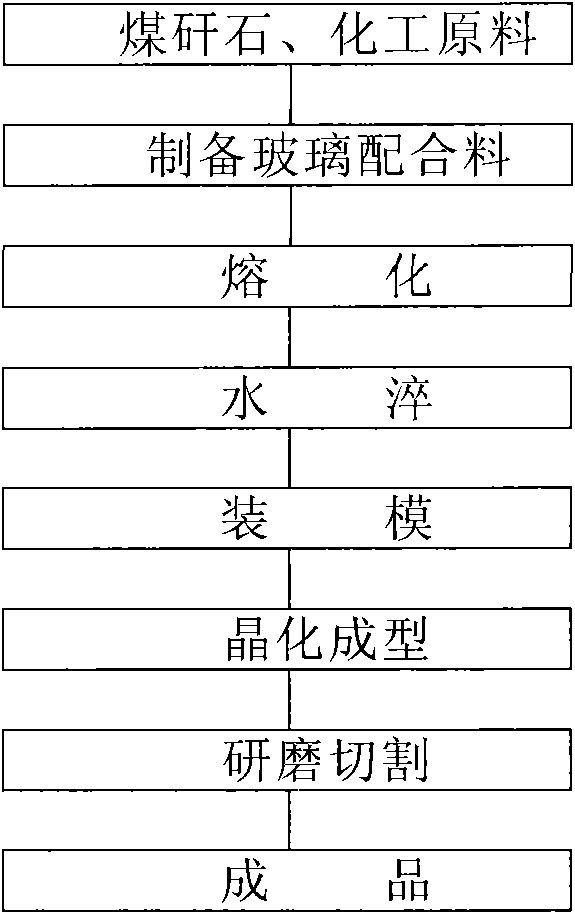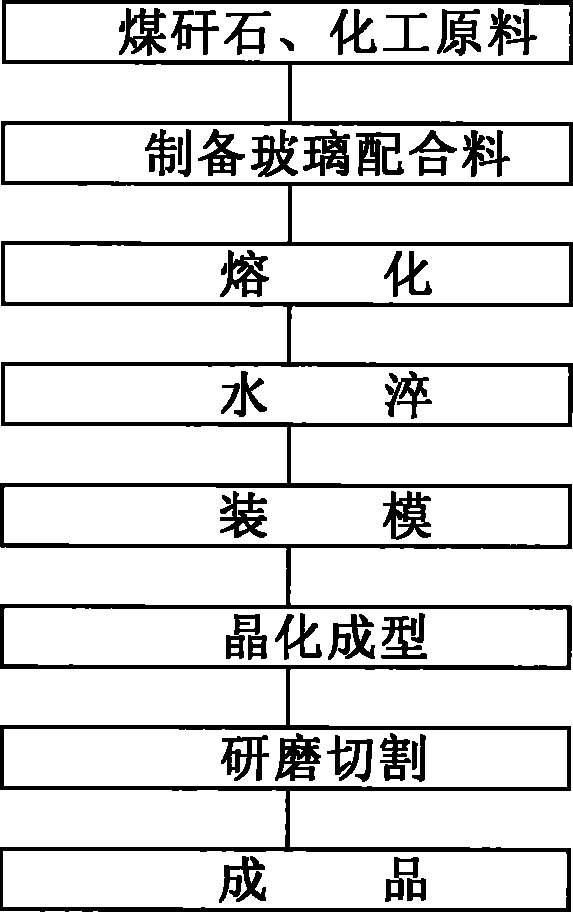Method utilizing coal gangue to manufacture microcrystalline glass plate material
A technology of glass-ceramics and coal gangue, which is applied in the field of glass-ceramic plate manufacturing, can solve problems such as aggravating the erosion of glass liquid on refractory materials of furnaces, aggravating the erosion of glass liquid on refractory materials of furnaces, and affecting the service life of equipment, etc., to achieve The effect of improving furnace efficiency, reducing energy consumption, and accelerating melting speed
- Summary
- Abstract
- Description
- Claims
- Application Information
AI Technical Summary
Problems solved by technology
Method used
Image
Examples
Embodiment 1
[0019] The glass batch is made by weighing and mixing. The composition of the glass batch is calculated in parts by weight: 70 parts of coal gangue, 24 parts of quartz, 8.5 parts of calcite, 4 parts of alumina, 9 parts of sodium carbonate, 5 parts of zinc oxide, 3 parts of barium carbonate.
[0020] Put the above-mentioned glass batch material in a mullite crucible and melt it in a box-type electric furnace at a temperature of 1460°C for 3.5 hours. After the melting is completed, pour the glass liquid into water to become glass pellets. 500 grams of glass granules were spread flat in a refractory mold with a size of 120×120 mm and crystallized in a box-type electric furnace at a crystallization temperature of 1020° C. A gray-black microcrystalline stone sample of 120×120×18 mm can be obtained.
Embodiment 2
[0022] The glass batch is made by weighing and mixing. The composition of the glass batch is calculated in parts by weight: 40 parts of coal gangue, 40 parts of quartz, 21 parts of calcite, 4.7 parts of alumina, 9 parts of sodium carbonate, 4 parts of zinc oxide, 5 parts of barium carbonate, 0.6 parts of copper oxide, and 0.5 parts of carbon powder.
[0023] The above-mentioned glass batch materials were melted in a glass tank furnace with a temperature of 1470° C. for 3.5 hours. After the melting was completed, the molten glass was directly poured into water to become glass pellets. Spread 20 kg of glass granules flat in a refractory mold with a size of 6000×9000 mm to carry out crystallization in a shuttle kiln fueled by liquefied petroleum gas, and the crystallization temperature is 1070°C. A copper-red microcrystalline stone product of 600×900×16 mm can be obtained.
Embodiment 3
[0025] The glass batch is made by weighing and mixing. The composition of the glass batch is calculated by weight: 40 parts of coal gangue, 42 parts of quartz, 18 parts of calcite, 4 parts of alumina, 7 parts of sodium carbonate, 6 parts of zinc oxide, 6 parts of barium carbonate, 0.1 part of copper oxide, 0.6 part of carbon powder.
[0026] The above-mentioned glass batch materials were melted in a glass tank kiln at a temperature of 1470° C. for 4 hours, and after the melting was completed, the molten glass was directly flowed into water to become glass pellets. Spread 26 kg of glass pellets in a refractory mold with a size of 6000×9000 mm and crystallize in a shuttle kiln fueled by liquefied petroleum gas at a crystallization temperature of 1050°C. A pink microcrystalline stone product of 600×900×18 mm can be obtained.
PUM
 Login to View More
Login to View More Abstract
Description
Claims
Application Information
 Login to View More
Login to View More - R&D
- Intellectual Property
- Life Sciences
- Materials
- Tech Scout
- Unparalleled Data Quality
- Higher Quality Content
- 60% Fewer Hallucinations
Browse by: Latest US Patents, China's latest patents, Technical Efficacy Thesaurus, Application Domain, Technology Topic, Popular Technical Reports.
© 2025 PatSnap. All rights reserved.Legal|Privacy policy|Modern Slavery Act Transparency Statement|Sitemap|About US| Contact US: help@patsnap.com



